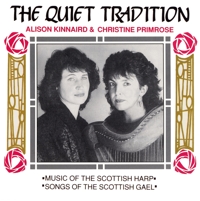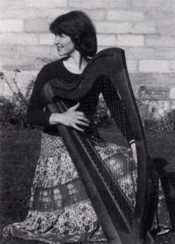Sleeve
Notes
1. Oran Do Mhac Leoid Dhuun Bheagain(song
to Macleod of Dunvegan)
One of the great songs in the bardic tradition, composed after
the death of Ian Breac MacLead in 1693,by the most famous Highland
harper, Ruaidhri Dall Morison,the blind harper. He was harper to
the Clan MacLeod at Dunvegan in Skye where he served the chief,
Iain Breac. In the song he begins by lamenting the passing of the
days of the old chief, who was one of the last great patrons of
the Gaelic bardic arts; how the castle is now empty and cold where
before it welcomed song and poetry. Twenty-eight verses of the
song survive-we have chosen two which describe first the playing
of the pipes to rouse the household and, in the following verse,
the calming effect of swift fingers on the strings of the harp.
The harper ends with an exhortation to Ruaidhri, the young chief,
not to leave the house of his father without music. Christine learned
the song from Rev. William Matheson. It has survived in the unbroken
tradition for the past 300 years. Christine's style of singing
is typical of Carloway in Lewis, only a few miles from where the
Blind Harper himself was born -so this is probably the most direct
link we can still have with the music of Ruaidhri Dall.
2. O'N Chir Mo Leannan Culaibh Rium/Do
Chrochadh A Thu (Since My darling Tuned from Me/You Deserve To
Hang)
Two unaccompanied puirt-a-beul, or mouth music. The first says
that since her boyfriend ignored her, she certainly won't be going
to the dance with him!
A version of the second, which has rather unusual timing, was collected
in South Uist from Mrs. John Currie of North Glendale by Margaret
Fay Shaw. It tells a nonsense story of Mairi who broke a dish and
stole the milk. Christine and Alison both sing the bass line!
3. Da Mihi Manum(Give Me Your Hand)
This tune is also found in Ireland under the title 'Give Me Your
Hand'(Thoir Dhomh do Lamh). It is said to have been composed
by the Irish harper, Ruairi Dall O Cathain, who lived in Scotland
for most of his life between c.1600 and c. 1650, The story goes
that he took offence at the off-hand reception which he was given
at the home of lady Eglinton in Ayrshire. When she was told of
his high standing as a harper she hastened to make amends, whereupon
he relented and composed this tune for her. However, it seems
more likely that it was composed by Ruairi O Cathain on the occasion
of the visit of James VI to the Earl of Eglinton's home near
Glasgow in 1617. This sealed a reconciliation between the monarch
and the Earl, whose title had been disputed by King James until
1615.This slightly unusual version of the melody came from one
of the earliest Scottish printed collections, Oswald's 'Caledonian
Pocket Companion' c.1750.
4.Tha Mi Fo Churam (I am full of
care)
This song was composed during the last century by Peigi Nighean
Eoin Mhic Mhaol Chaluim-Maol Calum was Maol Calum Maclnnes
of Leitir Fura in Sleat, Isle of Skye. (Leitir Fura is one of the
many places where today nothing is left except ruins in the once
populated area). His son went to Aird, Sleat and Peigi composed
this song for her lover Tormod MacNeacail, fear og Sgorabreac,
by whom she had a son. She says that she will follow him anywhere,
without possessions, without gold, without learning. Christine
learned this song from Christine Shaw, Isle of Harris.
5.Cailleach An Dudain (The Woman
Of the Mill-Dust)
This tune was used for one of the very old dances of the Hebrides,
the origins of which may go back to pagan times. The words sung
by Christine were collected by Alexander Carmichael. Various versions
of the melody exist, and it is commonly played on the pipes today.
It also appears in the Angus Fraser manuscript as 'Cailleach an
Durdan' (The Old Woman of the Humming), which may be the original
title- perhaps even a metaphor for the bagpipes.
6. O 'S Toil 'S Gu Ro Thoil Leam
(O I Like, I Do Like)
Women often sang men's love songs during a waulking - the fulling
of tweed, when the cloth would be rhythmically beaten on a board
to the accompaniment of their singing. We don't know who composed
this song or the circumstances behind it, although it contains
a lot of personal detail.
O I Like, I do like, O I like you
girl
Take my greetings to Dunvegan of the chanters and the
pipes
These other greetings across from me to the merchants of
Leith
To the boys in Harris, and to the piper
Alasdair
To Milady's page, although his were the
words that convicted me
Like the curly-haired woman,
although I didn't get her for my
own
Like her of the yellow
hair, who climbs the hill
(Published in a book of Orain Luaidh (Waulking
Songs) by the Harris Tweed Association)
7. Cumha Crann Nan Teud (The Lament
For The Harp Key)
This is Alison's version, with three of her own variations, of
a great tune common to the repertoire of the harp and pipes. (She
recorded Francis Collinson's arr of the same melody in 1978.) A
version of this tune is known to have been played by the Blind
Harper at a hunting party around the end of the 17th century. The
piobaireachd version of the tune uses the title 'Cumha Craobh Nan
Teud' (The Lament for the Tree of Strings) but it seems likely
that the word 'Craobh' which simply translates as 'Tree' has been
substituted for the word 'Crann' which indeed means Tree (with
all the underlying symbolism that that implies) but has also many
other meanings, among them 'plough', the 'mast of a ship' a 'harp
key' and in poetic verse as a phallic symbol. It is a truly majestic
tune which Alison chooses to interpret as a lament for a dying
tradition for bardic harp music.
8. Tha Thide Agam Eirigh (It Is
Time For Me To Rise)
A particularly poignant song, combining love-song and lament, this
is one of the very few narrative songs in the Gaelic language.
Christine does not know who composed it, but this version is associated
with the island of Lewis. It was recorded there by the School of
Scottish Studies from the singing of Angus Kenneth Maclver.
'When I came to the homestead the
house was not as it ought to be: my smooth, bright, brown-haired
girl lying in the chamber, lying beneath the window where
I could not hear her talk; lying on a board in her shroud,
still and cold.
Thou who did shape the words, keep
me from going mad, keep me from losing my reason-and let not
me endure more.'
9. The Crags or Ailsa/Staffa's shore
These two tunes appear in John Bowie's collection of music published
in 1789. In this book they are both simply called ‘Air
by Fingal' so Alison gave her arrangements of the melodies suitable
names to distinguish one from the other. Bowie's ascription to
the tunes reads 'The following pieces of Ancient music were furnished
to the Editor by a Gentleman of Note in the Highlands of Scotland,
were composed originally for the harp and which were handed down
to him by his Ancestors who learned the same of the famous Rory
Daul, a celebrated Harper in the Reign of Queen Ann - These tunes
are called in our language Ports, and were composed either for
Religious Worship or on Heroic Subjects'.
The second tune is rather reminiscent of Mendelssohn's 'Fingal's
Cave'- perhaps he was familiar with this melody which was certainly
published by the time he visited Scotland.
10. An Smeorach (The Thrush)/The
song -Thrush/The Mistle -Thrush
This little chant imitating the song of the thrush was recoded
from Calum Johnston of Barra in the 1950's. Alison made up the
two tunes after it-the first follows the notes of the Song-Thrush,
which repeats each musical motif twice. The second is called after
the Mistle Thrush, sometimes known as the Storm-Cock because it
is known to sing as a harbinger of bad weather.
11. Tha Na H-Uain Air An Tulaich
(The Lambs Are On The Hiloch)
This is a version of the Irish song 'The Lambs on the Green Hill'.
It was translated into Scottish Gaelic by John Alick MacPherson,
and Christine has adapted it so that it tells the story from the
girl's point of view. It is the sad tale of how she watched her
love getting married to someone else. Her pain is so great that
she just wishes to be buried beneath the green grass- that being
the only respite from her anguish. This motif is often used in
Gaelic song composition.
12. Port Lennox
A particular type of harp tune known as a 'port' existed in the
17th century and has survived in the lute manuscripts of that
period. Some of them are associated with the Irish harper Ruairi
O Cathain, but there appear to be many more 'Ports' than are
likely to have been composed by a single harper. Many of them
have titles which are linked with the Atholl area of Perthshire,
or with the Robertson family of Lude, who were great patrons
of the harpers. This version of the melody is found in the Skene
manuscript for fiddle or Lowland pipes, written around 1720.
13. Bean Mhic A' Mhaoir (The Wife
Of The Bailiff's Son)
This song was collected by Frances Tolmie on Skye and is one of
many versions of the classic ballad of the two sisters. It is supposedly
sung by the younger girl who was found sleeping on the seashore
by her jealous elder sister, who plaited her hair to the seaweed
and left her to drown in the rising tide. We had no tune for the
middle section so Christine composed the melody for the verse which
links the two parts of the song, singing as she sinks below the
ripples of harp music.
14. Sneachd Heisgeir(The Snows of
Heiskeir)/Sleepy Maggie
Christine and Alison have performed in schools in Uist and Lewis
on a number of occasions. A couple of years ago a tremendous gale
caused all the schools to close just as Alison flew into Benbcula.
(Christine was stormbound in Skye.) With twenty-four hours before
the next flight out, Alison settled down in Mrs Sheperd's comfortable
guesthouse, 'Heiskeir' to pass the time learning some new tunes.
While working on 'Sleepy Maggie' she found that a slow version
of the tune was taking shape, in time with the gusts of sleet and
hail on the window - the origins of the first tune 'The Snows Of
Heiskeir'. 'Sleepy Maggie' is well known as a dance tune
in Scotland and Ireland. This version comes from James Oswald's
'The Caledonian Pocket Companion' published between 1745 and 1759.
15. Mo Ghaol Oigfhear (My Dear Young
Man)
This song is said to have been
composed some time at the end of the last century by Marion
Gillies from Hiort, one of the group of St Kida Islands. These
are the most westerly and isolated of the Scottish islands
and were eventually evacuated in the 1930's. In the song she
tells of her feelings for the young Laird of Islay. An Tighearna
Ileach, with whom she had fallen in love when she visited Hiort.
In those days it was unheard of for one of her class to become
involved with somebody of noble birth but she cares nothing
for those who gossip and spread scandalous lies - she would
rather listen to his tender words. |
 Alison
Kinnaird and Christine Primrose are already well-known as outstanding
solo performers in their respective fields of traditional Gaelic
song and Scottish harp. Christines beautiful voice with its effortless
traditional style is accompanied by Alisons sensitive harp playing
in a way which does not detract from the character of the singing,
but supports it and adds an extra dimension to the music. Their
repertoire includes love songs, laments and descriptive pieces,
as well as lively dance music.
Alison
Kinnaird and Christine Primrose are already well-known as outstanding
solo performers in their respective fields of traditional Gaelic
song and Scottish harp. Christines beautiful voice with its effortless
traditional style is accompanied by Alisons sensitive harp playing
in a way which does not detract from the character of the singing,
but supports it and adds an extra dimension to the music. Their
repertoire includes love songs, laments and descriptive pieces,
as well as lively dance music.  Alison
Kinnaird comes from Edinburgh and studied cello from
the age of seven, and then Scottish harp music with Jean Campbell
from the age of fourteen. She studied Archaeology and Celtic
studies at Edinburgh University, and at that time began to take
an interest in establishing a repertoire of traditional melodies
which had been composed for the Scottish harp.
Alison
Kinnaird comes from Edinburgh and studied cello from
the age of seven, and then Scottish harp music with Jean Campbell
from the age of fourteen. She studied Archaeology and Celtic
studies at Edinburgh University, and at that time began to take
an interest in establishing a repertoire of traditional melodies
which had been composed for the Scottish harp. Christine
Primrose was born on the Isle of Lewis, spoke Gaelic
as her first language, and has been singing since she was a child.
Her beautiful voice and flawless traditional style have brought
her recognition as one of the foremost Gaelic singers of today.
Her first album produced in 1982 was 'Alte Mo Ghaoil' (Temple
TPOO6), the forerunner of a new generation of recordings by young
Gaelic singers. It broke through to an audience at home and abroad
who had never before listened to Gaelic song, but found that,
even though they did not understand the language, Christine's
singing could touch their hearts and emotions. Since then she
has toured the world and performed widely on radio and TV. Her
second album 'S tu nam chuimhne' (Temple TPO24) was released
in 1987 to critical acclaim.
Christine
Primrose was born on the Isle of Lewis, spoke Gaelic
as her first language, and has been singing since she was a child.
Her beautiful voice and flawless traditional style have brought
her recognition as one of the foremost Gaelic singers of today.
Her first album produced in 1982 was 'Alte Mo Ghaoil' (Temple
TPOO6), the forerunner of a new generation of recordings by young
Gaelic singers. It broke through to an audience at home and abroad
who had never before listened to Gaelic song, but found that,
even though they did not understand the language, Christine's
singing could touch their hearts and emotions. Since then she
has toured the world and performed widely on radio and TV. Her
second album 'S tu nam chuimhne' (Temple TPO24) was released
in 1987 to critical acclaim.









